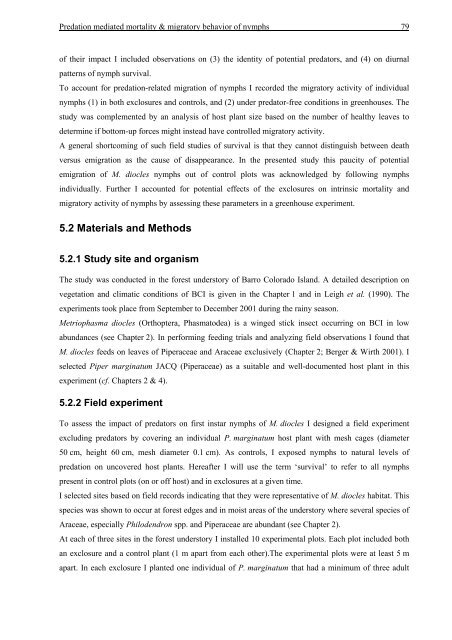ecology of phasmids - KLUEDO - Universität Kaiserslautern
ecology of phasmids - KLUEDO - Universität Kaiserslautern
ecology of phasmids - KLUEDO - Universität Kaiserslautern
Create successful ePaper yourself
Turn your PDF publications into a flip-book with our unique Google optimized e-Paper software.
Predation mediated mortality & migratory behavior <strong>of</strong> nymphs 79<br />
<strong>of</strong> their impact I included observations on (3) the identity <strong>of</strong> potential predators, and (4) on diurnal<br />
patterns <strong>of</strong> nymph survival.<br />
To account for predation-related migration <strong>of</strong> nymphs I recorded the migratory activity <strong>of</strong> individual<br />
nymphs (1) in both exclosures and controls, and (2) under predator-free conditions in greenhouses. The<br />
study was complemented by an analysis <strong>of</strong> host plant size based on the number <strong>of</strong> healthy leaves to<br />
determine if bottom-up forces might instead have controlled migratory activity.<br />
A general shortcoming <strong>of</strong> such field studies <strong>of</strong> survival is that they cannot distinguish between death<br />
versus emigration as the cause <strong>of</strong> disappearance. In the presented study this paucity <strong>of</strong> potential<br />
emigration <strong>of</strong> M. diocles nymphs out <strong>of</strong> control plots was acknowledged by following nymphs<br />
individually. Further I accounted for potential effects <strong>of</strong> the exclosures on intrinsic mortality and<br />
migratory activity <strong>of</strong> nymphs by assessing these parameters in a greenhouse experiment.<br />
5.2 Materials and Methods<br />
5.2.1 Study site and organism<br />
The study was conducted in the forest understory <strong>of</strong> Barro Colorado Island. A detailed description on<br />
vegetation and climatic conditions <strong>of</strong> BCI is given in the Chapter 1 and in Leigh et al. (1990). The<br />
experiments took place from September to December 2001 during the rainy season.<br />
Metriophasma diocles (Orthoptera, Phasmatodea) is a winged stick insect occurring on BCI in low<br />
abundances (see Chapter 2). In performing feeding trials and analyzing field observations I found that<br />
M. diocles feeds on leaves <strong>of</strong> Piperaceae and Araceae exclusively (Chapter 2; Berger & Wirth 2001). I<br />
selected Piper marginatum JACQ (Piperaceae) as a suitable and well-documented host plant in this<br />
experiment (cf. Chapters 2 & 4).<br />
5.2.2 Field experiment<br />
To assess the impact <strong>of</strong> predators on first instar nymphs <strong>of</strong> M. diocles I designed a field experiment<br />
excluding predators by covering an individual P. marginatum host plant with mesh cages (diameter<br />
50 cm, height 60 cm, mesh diameter 0.1 cm). As controls, I exposed nymphs to natural levels <strong>of</strong><br />
predation on uncovered host plants. Hereafter I will use the term ‘survival’ to refer to all nymphs<br />
present in control plots (on or <strong>of</strong>f host) and in exclosures at a given time.<br />
I selected sites based on field records indicating that they were representative <strong>of</strong> M. diocles habitat. This<br />
species was shown to occur at forest edges and in moist areas <strong>of</strong> the understory where several species <strong>of</strong><br />
Araceae, especially Philodendron spp. and Piperaceae are abundant (see Chapter 2).<br />
At each <strong>of</strong> three sites in the forest understory I installed 10 experimental plots. Each plot included both<br />
an exclosure and a control plant (1 m apart from each other).The experimental plots were at least 5 m<br />
apart. In each exclosure I planted one individual <strong>of</strong> P. marginatum that had a minimum <strong>of</strong> three adult

















